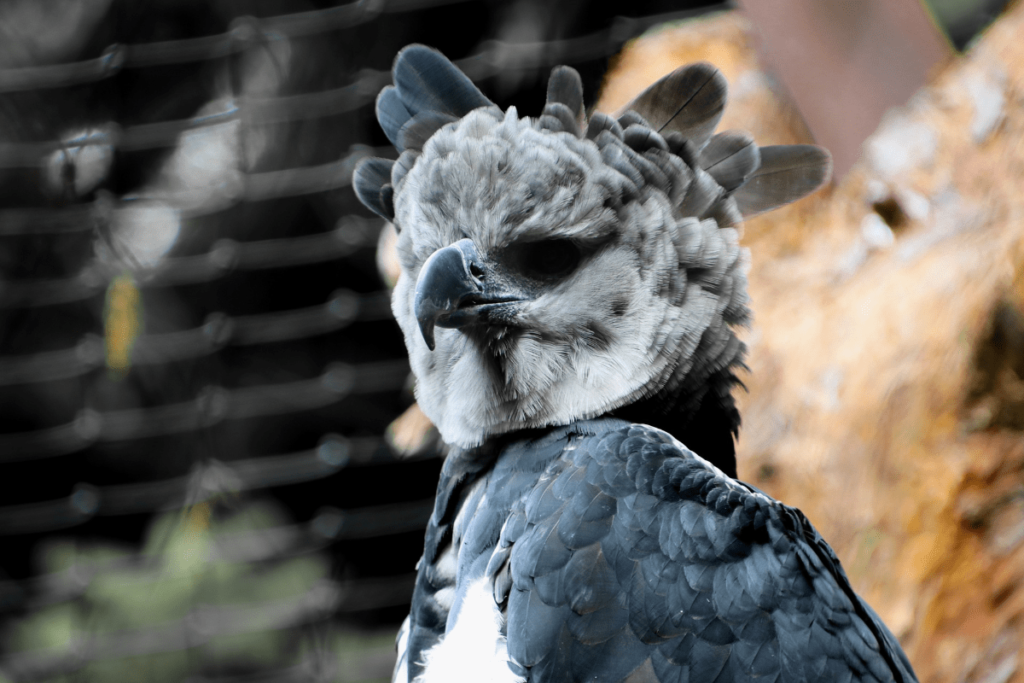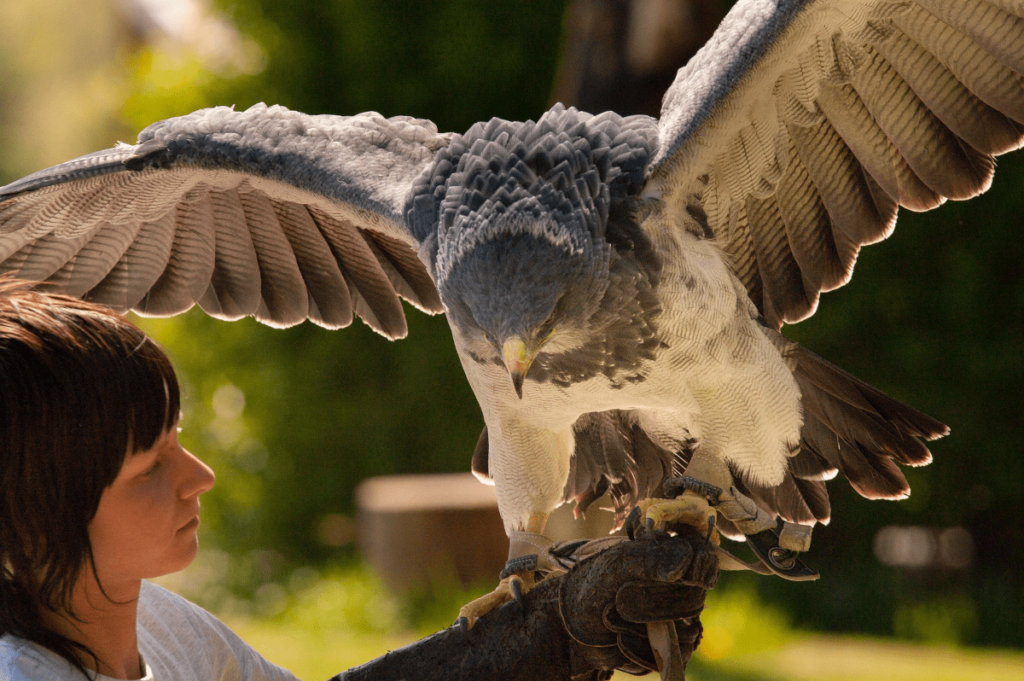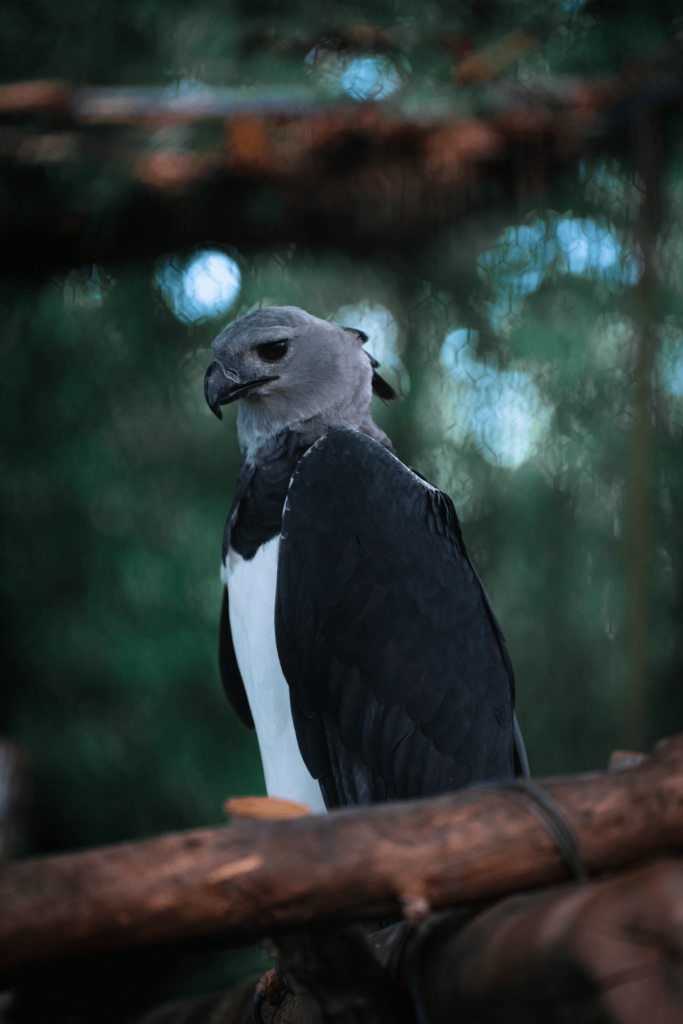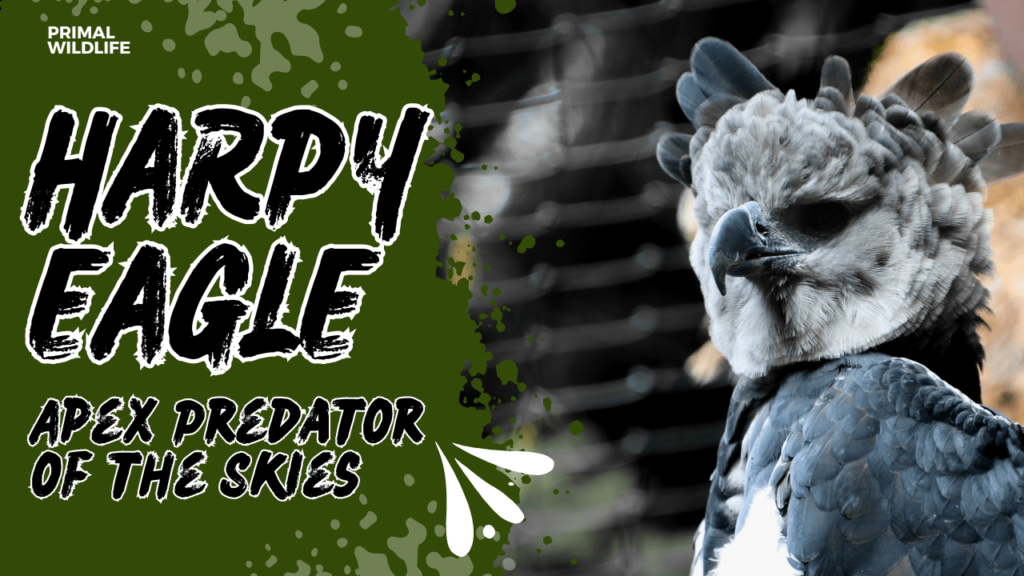The Harpy Eagle is one of the most extraordinary and powerful birds of prey on Earth. Known for its imposing presence and incredible strength, it has rightfully earned the title of one of the largest eagles in the world. With its distinctive crown of feathers and piercing gaze, the Harpy Eagle stands as a symbol of power and majesty in the animal kingdom.
Often referred to as the “King of the Rainforest,” this apex predator commands respect from both wildlife enthusiasts and researchers alike. Its formidable size and hunting prowess make it a fascinating subject for anyone interested in the intricacies of nature.
You might also be interested in reading about the King of the Jungle.
But there is much more to this eagle than just its strength. From its specialized Harpy Eagle diet to its unique nesting habits high up in the tallest trees of the rainforest, the Harpy Eagle’s behavior and adaptations have evolved to help it thrive in the dense forests of Central and South America.
Sadly, despite being one of the most powerful raptors, the Harpy Eagle faces increasing threats due to deforestation and human interference, making conservation efforts critical to its survival.

Animal Information Table:
| Common Name | Harpy Eagle |
|---|---|
| Scientific Name | Harpia harpyja |
| Family Name | Accipitridae |
| Type | Bird of Prey (Raptor) |
| Size (Head & Body Length) | 86-107 cm (2.8-3.5 feet) |
| Tail Length | Approx. 20-25 cm (8-10 inches) |
| Weight | Males: 6 kg (13 lbs); Females: 9 kg (20 lbs) |
| Size Relative to Human | Similar height to a 6-ft human when wings are spread |
| Diet | Carnivorous: Monkeys, sloths, birds, small mammals |
| Average Lifespan in the Wild | 25-35 years |
| Habitat | Rainforests of Central and South America |
| Group Name | Solitary |
| Found In | Panama, Brazil, Venezuela, Colombia, Ecuador, and other parts of Central and South America |
| Conservation Status | Near Threatened (IUCN Red List) |
In this article, we will explore various aspects of the Harpy Eagle’s life, from its impressive wingspan and hunting techniques to its conservation status and the challenges it faces in the modern world
Harpy Eagle: World’s Most Powerful Eagle
1. Physical Characteristics
Harpy Eagle’s physical characteristics:
| Scientific Name | Harpia harpyja |
| Body Length | 86-107 cm (2.8-3.5 feet) |
| Weight (Females) | Up to 9 kg (20 lbs) |
| Weight (Males) | Around 6 kg (13 lbs) |
| Wingspan | Up to 2 meters (6.5 feet) |
| Talons Length | Up to 13 cm (5 inches) |
| Beak | Strong, hooked beak for tearing prey |
| Eye Color | Typically dark brown |
| Plumage | Gray head, white underbelly, black wings, and crest of feathers |
| Leg Length | Thick, powerful legs covered with feathers |
| Claw Strength | Capable of exerting over 530 psi (pounds per square inch) of pressure |
| Flight Speed | Can reach speeds of up to 50 miles per hour (80 km/h) |
As the largest eagle in the world, the Harpy Eagle boasts a powerful build and substantial talons, making it a dominant predator in its rainforest habitat
The Harpy Eagle size is one of its most remarkable features. Females, which are typically larger than males, can weigh up to 20 pounds (9 kg), while males generally reach around 13 pounds (6 kg). With its large frame, it can stand up to 42 inches (107 cm) tall, making it one of the heaviest eagles in the world. Despite its significant bulk, the Harpy Eagle moves with grace and precision when hunting in the dense canopies of the rainforest.
Harpy Eagles even made it to our List of Top 11 Largest Birds in the World
A defining feature of the Harpy Eagle is its impressive wingspan. While it may not boast the longest wingspan among eagles, it stretches nearly 6.5 feet (2 meters). This relatively short but broad Harpy Eagle wingspan allows it to navigate through thick forest canopies with agility, enabling it to pursue prey with remarkable speed and control.
Of course, no description of the Harpy Eagle would be complete without mentioning its talons. The Harpy Eagle talons are perhaps its most powerful weapon. These talons can grow up to 5 inches (13 cm) long, comparable in size to the claws of a grizzly bear. With these, the eagle can exert enough force to crush the bones of its prey, making it a top predator in its environment.
Harpy Eagle Next to Human

2. Habitat and Distribution
Where do Harpy Eagles live? The Harpy Eagle habitat is primarily located in the tropical rainforests of Central and South America. Their range extends from southern Mexico to northern Argentina, but the majority are found in the Amazon Rainforest, which provides the dense tree cover they prefer. Harpy Eagles rely on tall, mature forests to thrive, building their nests high up in the tallest trees such as the kapok or silk-cotton trees.
The formidable relative of Harpy Eagle, the Golden Eagle is celebrated as one of the fastest animals in the world, renowned for its remarkable speed and agility in the sky, beating even the speed of Cheetah.
Despite their large size and dominance, the Harpy Eagle’s habitat is under threat. As deforestation continues to shrink the rainforests, the eagle’s territory is being fragmented, making it harder for these birds to find suitable nesting sites and hunting grounds. Preservation of the Harpy Eagle habitat is crucial for the survival of this species, as they require large territories to hunt and breed successfully.
Harpy Eagle Images:

3. Hunting Abilities and Diet
The Harpy Eagle hunting abilities are truly extraordinary. This bird is an ambush predator, relying on the element of surprise to capture its prey. Unlike many other eagles that prefer to soar above open spaces, the Harpy Eagle hunts within the forest canopy, where its short, broad wings give it the maneuverability to chase animals through the trees.
The Harpy Eagle diet consists mainly of medium-sized mammals. Sloths and monkeys are their primary prey, but they have also been known to catch opossums, snakes, and even large birds like macaws. A unique feature of the Harpy Eagle diet is its specialization in catching arboreal (tree-dwelling) animals, which allows it to hunt in areas where other large predators cannot reach.
What sets the Harpy Eagle apart is not just its strength, but also its patience. These birds are known to sit and wait for long periods, watching for the slightest movement before launching a swift, deadly attack. With the help of their powerful Harpy Eagle talons, they can grab and lift animals that weigh as much as themselves.
You might also be interested in The Secrets Behind Eagle’s Hunting Techniques

4. Life Cycle and Reproduction

The Harpy Eagle lifespan is impressive, with these birds living up to 35 years in the wild. However, they are slow to reproduce.
Harpy eagles generally mate for life and raise only one chick every 2-3 years. The female lays a single egg, and both parents take turns incubating it.
Once the chick hatches, it remains in the nest for several months, depending on its parents for food and protection.
Nesting typically takes place in the tallest trees in the forest. These nests can be up to 5 feet (1.5 meters) wide, providing a safe space for the young eagle.
The long rearing period and low reproductive rate make the Harpy Eagle particularly vulnerable to threats such as habitat destruction and hunting.
5. Conservation Status and Threats
Despite its status as a powerful predator, the largest harpy eagle is facing a decline in numbers. The Harpy Eagle is currently listed as Near Threatened on the IUCN Red List due to habitat loss and human interference. The destruction of rainforests for agriculture and logging has significantly reduced their natural hunting and nesting areas.
Efforts to protect the Harpy Eagle include habitat preservation and breeding programs. Organizations like The Peregrine Fund are working to raise awareness and reintroduce harpy eagles to areas where their populations have declined. Conservationists stress that preserving the Harpy Eagle habitat is not only important for the survival of these majestic birds but also for the overall health of the ecosystems they inhabit.

6. The Harpy Eagle’s Symbolic Importance
In addition to its physical attributes, the Harpy Eagle holds a significant place in the culture of the regions it inhabits. It is the national bird of Panama, where it is revered for its strength and beauty.
Throughout history, the Harpy Eagle has been a symbol of power in many indigenous cultures across Central and South America, often seen as a guardian of the forest.
In mythology, the Harpy Eagle has been associated with the harpies of Greek legend, fierce winged creatures known for their ferocity and cunning.
Though the eagle shares only its name with these mythical beings, the comparison speaks to the reverence people have had for this bird throughout the ages.

Frequently Asked Questions about Harpy Eagles:
1. Where do Harpy Eagles live?
Harpy Eagles primarily inhabit tropical rainforests in Central and South America. They are found from southern Mexico to northern Argentina.
2. How big is a Harpy Eagle?
Harpy Eagles are large birds with a body length of 86-107 cm (2.8-3.5 feet) and a wingspan of up to 2 meters (6.5 feet).
3. What do Harpy Eagles eat?
Harpy Eagles primarily prey on medium-sized mammals such as sloths and monkeys, but they also eat birds and reptiles.
4. Where are Harpy Eagles found?
Harpy Eagles are found in the rainforests of countries including Panama, Brazil, Venezuela, Colombia, and Ecuador.
5. How tall is a Harpy Eagle?
A Harpy Eagle can stand up to 42 inches (107 cm) tall, with a significant wingspan that contributes to its impressive stature.
6. How much can a Harpy Eagle carry?
Harpy Eagles can carry prey weighing up to 2.2 kg (4.8 lbs) in their powerful talons.
7. How much weight can a Harpy Eagle carry?
Harpy Eagles are capable of carrying prey up to around 2.2 kg (4.8 lbs) due to their strong talons and large size.
8. How tall are Harpy Eagles?
Harpy Eagles can reach heights of up to 42 inches (107 cm) when fully grown.
9. What eats Harpy Eagles?
Adult Harpy Eagles have few natural predators, but young eagles may fall prey to larger raptors or mammals. Habitat loss and human activities are significant threats.
10. What is a Harpy Eagle?
The Harpy Eagle is a large and powerful bird of prey known for its impressive size, strong talons, and its role as an apex predator in the rainforest.
11. How much does a Harpy Eagle weigh?
Females weigh between 6-9 kg (13-20 lbs), while males are generally lighter, weighing around 6 kg (13 lbs).

Conclusion
Harpy Eagle is often celebrated as the largest eagle in the world, distinguished by its formidable size and impressive wingspan that can reach up to 2 meters (6.5 feet)
The Harpy Eagle is truly one of nature’s marvels, combining power, grace, and intelligence in equal measure. With its large size, formidable talons, and keen hunting skills, it has earned its reputation as one of the largest eagles in the world. Yet, despite its dominance, the Harpy Eagle faces significant threats from habitat loss and human activity. Protecting this majestic bird is crucial, not only for its survival but for maintaining the delicate balance of the rainforest ecosystem.
We must work together to ensure that future generations continue to be awed by the sight of the Harpy Eagle soaring through the rainforest. Share your thoughts about this incredible bird in the comments, and don’t forget to share this article with other wildlife enthusiasts!




